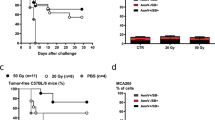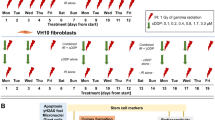Abstract
Colon carcinoma cells subjected to γ-irradiation (4 Gy) manifest signs of apoptosis (caspase activation, chromatin condensation, phosphatidylserine (PS) exposure on the cell surface, sub-diploid DNA content), correlating with their radiosensitivity, which is increased in cells lacking the 14-3-3σ protein as compared to wild-type controls. Inhibition of caspases by addition of Z-Val-Ala-DL-Asp (OMe)-fluoromethylketone, by stable transfection with the Baculovirus gene coding for p35, or by Bax knockout reduced all signs of apoptosis, yet failed to suppress radio-induced micro- and multinucleation. Moreover, pharmacological caspase inhibition, p35 expression or Bax knockout had no effect on the clonogenic survival that was reduced by γ-irradiation and caspase inhibition failed to abolish the increased radiosensitivity of 14-3-3σ-deficient cells. Micro- and multinucleation was detectable among non-apoptotic cells lacking PS exposure, as well as among cells undergoing apoptosis. Moreover, a fraction of micro- or multinucleated cells manifested caspase activation, and videomicroscopic analyses revealed that such cells could succumb to caspase-dependent apoptosis. Altogether, these results suggest that genomic instability induced by γ-irradiation can trigger apoptosis, although apoptosis is dispensable for radio-induced clonogenic death.
This is a preview of subscription content, access via your institution
Access options
Subscribe to this journal
Receive 50 print issues and online access
$259.00 per year
only $5.18 per issue
Buy this article
- Purchase on Springer Link
- Instant access to full article PDF
Prices may be subject to local taxes which are calculated during checkout










Similar content being viewed by others
Abbreviations
- Casp-3a:
-
activated caspase-3
- FACS:
-
fluorescence-activated cell sorter
- GFP:
-
green fluorescent protein
- MN:
-
micronuclei
- PI:
-
propidium iodide
- PS:
-
phosphatidylserine
- STS:
-
staurosporine
References
Adams JM . (2003). Genes Dev 17: 2481–2495.
Albertini RJ, Anderson D, Douglas GR, Hagmar L, Hemminki K, Merlo F et al. (2000). Mutat Res 463: 111–172.
Andreau K, Castedo M, Perfettini JL, Roumier T, Pichart E, Souquere S et al. (2004). J Biol Chem 279: 55937–55945.
Brown JM, Attardi LD . (2005). Nat Rev Cancer 5: 231–237.
Bulavin DV, Tararova ND, Aksenov ND, Pospelov VA, Pospelova TV . (1999). Oncogene 18: 5611–5619.
Bush C, McMillan TJ . (1993). Br J Cancer 67: 102–106.
Castedo M, Coquelle A, Vivet S, Vitale I, Kauffman A, Dessen P et al. (2006). EMBO J 25: 2584–2595.
Castedo M, Hirsch T, Susin SA, Zamzami N, Marchetti P, Macho A et al. (1996). J Immunol 157: 512–521.
Castedo M, Perfettini JL, Medema JP, Kroemer G . (2004a). Oncogene 23: 2825–2837.
Castedo M, Perfettini JL, Roumier T, Valent A, Raslova H, Yakushijin K et al. (2004b). Oncogene 23: 4362–4370.
Castedo M, Perfettini JL, Roumier T, Yakushijin K, Horne DA, Medema R et al. (2004c). Oncogene 23: 4353–4361.
Chan TA, Hermeking H, Lengauer C, Kinzler KW, Vogelstein B . (1999). Nature 401: 616–620.
Cohen-Jonathan EC, Bernhard EJ, McKenna WG . (1999). Curr Opin Chem Biol 3: 77–83.
Danial NN, Korsmeyer S . (2004). Cell 116: 205–219.
Date T, Luo Z, Yamakawa M, Belanger AJ, Scaria A, Cheng SH et al. (2003). Hum Gene Ther 14: 947–957.
Dewey WC, Ling CC, Meyn RE . (1995). Int J Radiat Oncol Biol Phys 33: 781–796.
Ferri KF, Jacotot E, Blanco J, Esté JA, Zamzami A, Susin SA et al. (2000). J Exp Med 192: 1081–1092.
Golstein P, Kroemer G . (2005). Cell Death Differ 12 (Suppl 2): 1490–1496.
Gourdier I, Crabbe L, Andreau K, Pau B, Kroemer G . (2004). Oncogene 23: 7449–7457.
Green DR, Kroemer G . (1998). Trends Cell Biol 8: 267–271.
Green DR, Kroemer G . (2004). Science 305: 626–629.
Gudkov AV, Komarova EA . (2003). Nat Rev Cancer 3: 117–129.
Guo GZ, Sasai K, Oya N, Takagi T, Shibuya K, Hiraoka M . (1998). Int J Radiat Biol 73: 297–302.
Held KD . (1997). Apoptosis 2: 265–282.
Hendry JH, West CM . (1997). Int J Radiat Biol 71: 709–719.
Hirsch T, Marchetti P, Susin SA, Dallaporta B, Zamzami N, Marzo I et al. (1997). Oncogene 15: 1573–1582.
Igney FH, Krammer PH . (2002). Nat Rev Cancer 2: 277–288.
Jallepalli PV, Lengauer C, Vogelstein B, Bunz F . (2003). J Biol Chem 278: 20475–20479.
Kroemer G, El-Deiry WS, Golstein P, Peter ME, Vaux DL, Vandenabeele P et al. (2005). Cell Death Differ 12: 1463–1467.
Kroemer G, Martin SJ . (2005). Nat Med 11: 725–730.
Kyprianou N, King ED, Bradbury D, Rhee JG . (1997). Int J Cancer 70: 341–348.
Lowe SW, Cepero E, Evan G . (2004). Nature 432: 307–315.
Mariya Y, Streffer C, Fuhrmann C, Wojcik A . (1997). Radiat Res 147: 29–34.
Methot N, Huang J, Coulombe N, Vaillancourt JP, Rasper D, Tam J et al. (2004). J Exp Med 199: 199–207.
Muller WU, Streffer C, Wuttke K . (1995). Stem Cells 13 (Suppl 1): 199–206.
Okada H, Mak TW . (2004). Nat Rev Cancer 4: 519–603.
Olive PL, Durand RE . (1997). Int J Radiat Biol 71: 695–707.
Perfettini JL, Castedo M, Nardacci R, Ciccosanti F, Boya P, Roumier T et al. (2005). J Exp Med 201: 279–289.
Prise KM, Schettino G, Folkard M, Held KD . (2005). Lancet Oncol 6: 520–528.
Roninson IB, Broude EV, Chang BD . (2001). Drug Resist Update 4: 303–313.
Schmitt CA . (2003). Nat Rev Cancer 3: 286–295.
Schulze-Bergkamen H, Krammer PH . (2004). Semin Oncol 31: 90–119.
Stennicke HR, Ryan CA, Salvesen GS . (2002). Trends Biochem Sci 27: 94–101.
Vidair CA, Chen CH, Ling CC, Dewey WC . (1996). Cancer Res 56: 4116–4118.
Zhang L, Yu J, Park BH, Kinzler KW, Vogelstein B . (2000). Science 290: 989–992.
Zhivotovsky B, Kroemer G . (2004). Nat Rev Mol Cell Biol 117: 4461–4468.
Acknowledgements
We thank Abdelali Jalil and Yann Leclues (Institut Gustave Roussy, Villejuif, France) for expert assistance in confocal microscopy and FACS analysis. GK is supported by Ligue contre le Cancer and European Commission (Active p53).
Author information
Authors and Affiliations
Corresponding author
Additional information
Supplementary Information accompanies the paper on the Oncogene website (http://www.nature.com/onc).
Supplementary information
Rights and permissions
About this article
Cite this article
Zhang, P., Castedo, M., Tao, Y. et al. Caspase independence of radio-induced cell death. Oncogene 25, 7758–7770 (2006). https://doi.org/10.1038/sj.onc.1209744
Received:
Revised:
Accepted:
Published:
Issue Date:
DOI: https://doi.org/10.1038/sj.onc.1209744
Keywords
This article is cited by
-
STING enhances cell death through regulation of reactive oxygen species and DNA damage
Nature Communications (2021)
-
The in vitro immunogenic potential of caspase-3 proficient breast cancer cells with basal low immunogenicity is increased by hypofractionated irradiation
Radiation Oncology (2015)
-
Delayed cell death associated with mitotic catastrophe in γ-irradiated stem-like glioma cells
Radiation Oncology (2011)
-
Multipolar mitosis of tetraploid cells: inhibition by p53 and dependency on Mos
The EMBO Journal (2010)
-
Prevention of premature senescence requires JNK regulation of Bcl-2 and reactive oxygen species
Oncogene (2010)



